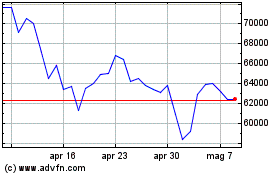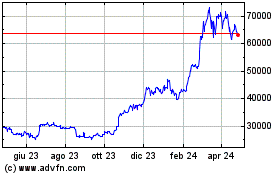

Bitcoin (BTC) price
bounced quickly from its five-month low of $74,300 to reach $83,565
on April 9, but the rejection from the $83,500 level raises
questions about whether BTC will be able to hold the $80,000
zone.
BTC/USD daily chart. Source:
Cointelegraph/TradingView
Will Trump’s 90-day tariff pause create a BTC trend
reversal?
On April 9, US President Donald Trump authorized a
90-day pause on proposed tariff hikes while introducing a
blanket 10% reciprocal tariff on all countries except China. In
contrast to his broader olive branch, Trump doubled down on his
trade war with China, escalating tariffs on Chinese imports to the
US to 125%, citing
Beijing's lack of "respect for world markets."
This move triggered a historic market rally, with
Bitcoin
surging over 7% to $82,000 as investor nerves eased. The pause
offers temporary relief, reducing immediate trade war fears that
had previously tanked risk assets.
However, China’s
retaliatory 84% tariffs on US imports, effective April 10,
signal an escalating standoff. If negotiations fail and the
US-China trade
war deepens after the 90-day window, Bitcoin could face renewed
downward pressure as markets recoil from heightened
uncertainty.
“With China singled out so explicitly, market participants are
bracing for Beijing's counterpunch,” trading firm QCP Capital wrote
in a Telegram note to investors.
QCP Capital added:
“Should retaliation materialize in force, the exuberant
rally could quickly morph into a classic bull trap.”
While the pause buys time, its ability to prevent a crash hinges
on whether Trump can de-escalate tensions with China—a tall order,
given his aggressive rhetoric.
Inflationary pressures could weigh down BTC price
Another factor adding to Bitcoin price headwinds is
macroeconomic factors like inflation fears and potential
recessions.
Bitcoin has increasingly
correlated with tech stocks and broader market sentiment, as
seen in its sharp declines during periods of market turmoil. For
instance, when Trump’s initial tariff announcements triggered a
sell-off in equities, Bitcoin dropped nearly 10% from its highs
earlier this year, slipping below
$80,000.
Analysts argue that if trade tensions escalate further or
central banks tighten monetary policy to combat inflation,
investors may flee risk assets like Bitcoin, pushing its price
lower.
This sensitivity to macroeconomic shifts suggests that any
sudden economic shock—like a Federal Reserve rate hike or a global
growth slowdown—could spark another crash, especially if Bitcoin
fails to break its current trading range of $80,000-$90,000.
Market participants now shift their focus on the April 10 CPI
data, which is poised to refocus attention on the domestic
economy.
“A weaker print would be welcome,” QCP capital said, adding that
it would help to “offset the inflationary overhang introduced by
the blanket tariff policy.”
Lowering interest rates is unlikely before June, despite one Fed
meeting scheduled in the interim, according to CME Group’s
FedWatch
Tool.

Fed target rate probabilities for the May 7 FOMC meeting.
Source:
CME Group
The odds of the Fed keeping interest rates unchanged at the May
7 meeting are 81.5%.
This could further dampen enthusiasm for BTC and push its price
lower if key price levels do not hold.
Related: Bitcoin price soars to $83.5K — Have pro BTC
traders turned bullish?
Key Bitcoin levels to watch
Bitcoin breached
the $75,000 level on April 8 before retracing to the current
levels. Traders are now focused on key areas around this level and
the $109,000
peak, which the BTC price might revisit in the near future.
From a technical perspective, key Bitcoin levels to watch are
the 111-day moving average (MA) at $93,000, the 200-day MA at
$87,000 and the 365-day MA at $76,000, according to market
intelligence firm Glassnode.
In its latest Week's On-chain report from Glassnode
highlights
that after losing the 111-day MA and the 200-day MA in the recent
drawdowns, the price must now hold above the 365-day MA to avoid
another crash.
“This is a key momentum level that has thus far held as
support but needs to remain as support to avoid further downside
momentum from being established.”

Bitcoin: Technical levels to watch. Source:
Glassnode
Another level to watch, according to Glassnode, is the
short-term holder (STH) cost basis at $93,000 (coinciding with the
111-day MA), which, if reclaimed, would signal the first sign of
strengthening momentum.
However, if Bitcoin fails to hold above $80,000, it will embark
on another downward path. Key levels to watch below the 365-day EMA
are the active realized price at $71,000 and, in dire cases, the
true market mean of around $65,000.
“We now have confluence across several onchain price
models, highlighting the $65k to $71k price range as a critical
area of interest for the bulls to establish long-term
support”

Bitcoin: True market mean. Source: Glassnode
As earlier reported by Cointelegraph, Bitcoin risks
another sweep of the five-month lows at $71,000 if the tariff wars
and stock market tumult continue.
This article does not
contain investment advice or recommendations. Every investment and
trading move involves risk, and readers should conduct their own
research when making a decision.
...
Continue reading Is Bitcoin price going to crash
again?
The post
Is Bitcoin price going to crash again? appeared
first on
CoinTelegraph.
Grafico Azioni Bitcoin (COIN:BTCUSD)
Storico
Da Mar 2025 a Apr 2025

Grafico Azioni Bitcoin (COIN:BTCUSD)
Storico
Da Apr 2024 a Apr 2025
